



STUDiOFOAM, Le Bureau Vivant, 2020. Leather. Image © STUDiOFOAM
Pillow Talk
STUDiOFOAM x Freia Achenbach
17 May 2021
Pillow Talk is the latest concept from COLLECTIBLE In-Depth. This series of articles instigates design encounters in a playful setting. The idea is simple: we pair designers from the Curated Section and each duo then freely chooses three questions to ask to each other. They can tackle any subject, within the realm of design - or not! Today’s duo is Freia Achenbach and Caroline Venet from STUDiOFOAM.
Caroline Venet: What is the last curiosity you noticed or collected which inspired you?
Freia Achenbach: For some time now, I've been fascinated by all kinds of found natural scraps, like onion skins, tree bark, and flower petals. Not only are their shapes and textures inspiring, but I also experiment with them to dye textiles in a natural way. The shades are always surprising and have something very sensual.
“I do observe interactions between user and object and also like to turn them upside-down from time-to-time in order to let new gestures and perceptions emerge as a result.”
CV: Of the material tensioning and shaping processes that you have experienced, which was the most challenging?
FA: Last year, we worked with the design studio Anima Ona on a carpet with a 7-meter diameter using a special foam printing process for the exhibition Places to be at the Fondation d'entreprise Martell in Cognac. By applying heat, the foam expands and brings tension to the printed textile, creating a three-dimensional relief. It was a very exciting process with many factors involved in its success, but the size of the object, in particular, presented us with unexpected challenges. For me, it is precisely these challenges in the process that challenge me as a designer and can lead to new solutions.
CV: Some of your works call new choreographies of gesture for the user. If you would have to think about a performance to show one of your creations, what would it be?
FA: I do observe interactions between user and object and also like to turn them upside-down from time-to-time in order to let new gestures and perceptions emerge as a result. That's why I find theater very exciting as a type of performance. It lets people completely immerse themselves in a work of art, which takes them out of their everyday lives and makes the unfamiliar tangible and perceptible.

Freia Achenbach, Spectator Shelf, 2019. Plastic. Image © Freia Achenbach
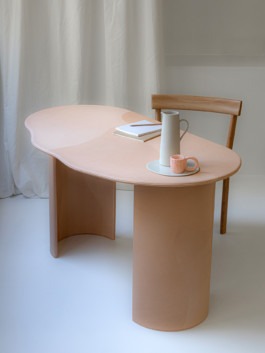
STUDiOFOAM, Le Bureau Vivant, 2020. Leather. Image © STUDiOFOAM
Freia Achenbach: In your work, the perception of materials plays a major role. What influence does the increasing digitality have on your own perception of materiality?
Caroline Venet: The short-lived aspect of digitality possibly contributes to make me design more unique pieces, lasting and timeless projects. The more immaterial our environment will be, the more tangible, soft or textured my work should be. Playing with our perception of materials is playing with our senses, from the first glance to the sense of touch, a medium of emotions that can't be digitally reached.
“I am learning to pass down, to share my work and thoughts in the best way with design students in this unprecedented period.”
FA: What tensions have arisen for you as a result of the current global situation and how do you use them for your work?
CV: A consequence of this crisis is the lack of jobs, as a designer and set designer, a daily tension to manage. It gave me time to be more conscious and involved in my design practice. I am focussing on the essence of my work. The tension due to the closing down of all “non-essential” places made me draw on my resources to freshen my mind and keep on going as a creative. It possibly made me maximize even more resources as a maker.
FA: What are you currently learning that is new to you?
CV: I am learning to pass down, to share my work and thoughts in the best way with design students in this unprecedented period.
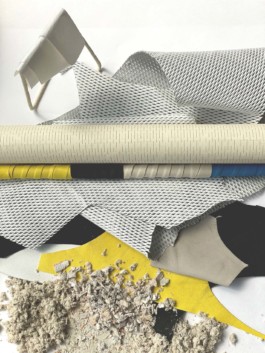
STUDiOFOAM, Samples. Image © STUDiOFOAM.
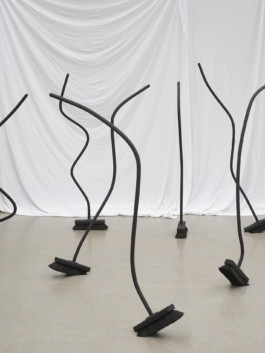
Freia Achenbach. Image © Freia Achenbach
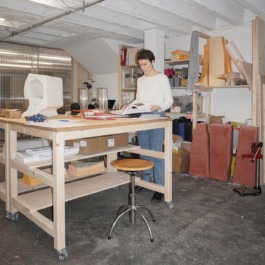
Freia Achenbach portrait. Image © Freia Achenbach.
About Freia Achenbach (Germany)
Freia Achenbach is a Stuttgart-based object, furniture, and spatial designer. Her approach allows movement between disciplines and playfully explores material, form, and colour. In her work Freia Achenbach experiments with a wide variety of materials and both traditional and innovative manufacturing processes.
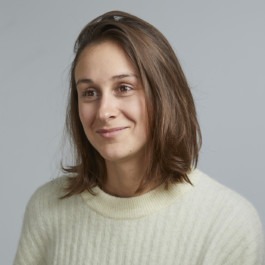
Caroline Venet Portrait. Image © STUDiOFOAM.
About STUDiOFOAM (France)
Through the Paris-based STUDiOFOAM founded in 2018, French designer Caroline Venet questions techniques and manufacturing processes, while working with upcycled materials and sustainable matter to highlight crafts and local knowledge. Her approach spans across a wide range of design disciplines as she plays with our sensory perception - from experimentation and material reuse, to surface and product design, furniture, and scenography.
Pillow Talk
STUDiOFOAM x Freia Achenbach
17 May 2021

STUDiOFOAM, Le Bureau Vivant, 2020. Leather. Image © STUDiOFOAM
Pillow Talk is the latest concept from COLLECTIBLE In-Depth. This series of articles instigates design encounters in a playful setting. The idea is simple: we pair designers from the Curated Section and each duo then freely chooses three questions to ask to each other. They can tackle any subject, within the realm of design - or not! Today’s duo is Freia Achenbach and Caroline Venet from STUDiOFOAM.
Caroline Venet: What is the last curiosity you noticed or collected which inspired you?
Freia Achenbach: For some time now, I've been fascinated by all kinds of found natural scraps, like onion skins, tree bark, and flower petals. Not only are their shapes and textures inspiring, but I also experiment with them to dye textiles in a natural way. The shades are always surprising and have something very sensual.
“I do observe interactions between user and object and also like to turn them upside-down from time-to-time in order to let new gestures and perceptions emerge as a result.”
CV: Of the material tensioning and shaping processes that you have experienced, which was the most challenging?
FA: Last year, we worked with the design studio Anima Ona on a carpet with a 7-meter diameter using a special foam printing process for the exhibition Places to be at the Fondation d'entreprise Martell in Cognac. By applying heat, the foam expands and brings tension to the printed textile, creating a three-dimensional relief. It was a very exciting process with many factors involved in its success, but the size of the object, in particular, presented us with unexpected challenges. For me, it is precisely these challenges in the process that challenge me as a designer and can lead to new solutions.
CV: Some of your works call new choreographies of gesture for the user. If you would have to think about a performance to show one of your creations, what would it be?
FA: I do observe interactions between user and object and also like to turn them upside-down from time-to-time in order to let new gestures and perceptions emerge as a result. That's why I find theater very exciting as a type of performance. It lets people completely immerse themselves in a work of art, which takes them out of their everyday lives and makes the unfamiliar tangible and perceptible.

Freia Achenbach, Spectator Shelf, 2019. Plastic. Image © Freia Achenbach

STUDiOFOAM, Le Bureau Vivant, 2020. Leather. Image © STUDiOFOAM
Freia Achenbach: In your work, the perception of materials plays a major role. What influence does the increasing digitality have on your own perception of materiality?
Caroline Venet: The short-lived aspect of digitality possibly contributes to make me design more unique pieces, lasting and timeless projects. The more immaterial our environment will be, the more tangible, soft or textured my work should be. Playing with our perception of materials is playing with our senses, from the first glance to the sense of touch, a medium of emotions that can't be digitally reached.
“I am learning to pass down, to share my work and thoughts in the best way with design students in this unprecedented period.”
FA: What tensions have arisen for you as a result of the current global situation and how do you use them for your work?
CV: A consequence of this crisis is the lack of jobs, as a designer and set designer, a daily tension to manage. It gave me time to be more conscious and involved in my design practice. I am focussing on the essence of my work. The tension due to the closing down of all “non-essential” places made me draw on my resources to freshen my mind and keep on going as a creative. It possibly made me maximize even more resources as a maker.
FA: What are you currently learning that is new to you?
CV: I am learning to pass down, to share my work and thoughts in the best way with design students in this unprecedented period.

STUDiOFOAM, Samples. Image © STUDiOFOAM.

Freia Achenbach. Image © Freia Achenbach

Freia Achenbach portrait. Image © Freia Achenbach.
About Freia Achenbach (Germany)
Freia Achenbach is a Stuttgart-based object, furniture, and spatial designer. Her approach allows movement between disciplines and playfully explores material, form, and colour. In her work Freia Achenbach experiments with a wide variety of materials and both traditional and innovative manufacturing processes.

Caroline Venet Portrait. Image © STUDiOFOAM.
About STUDiOFOAM (France)
Through the Paris-based STUDiOFOAM founded in 2018, French designer Caroline Venet questions techniques and manufacturing processes, while working with upcycled materials and sustainable matter to highlight crafts and local knowledge. Her approach spans across a wide range of design disciplines as she plays with our sensory perception - from experimentation and material reuse, to surface and product design, furniture, and scenography.
Contact
info@collectible.design
VIP PORTAL
EXHIBITOR PORTAL
PRIVACY POLICY
© 2025 Collectible
Contact
info@collectible.design
VIP PORTAL
EXHIBITOR PORTAL
PRIVACY POLICY
© 2025 Collectible